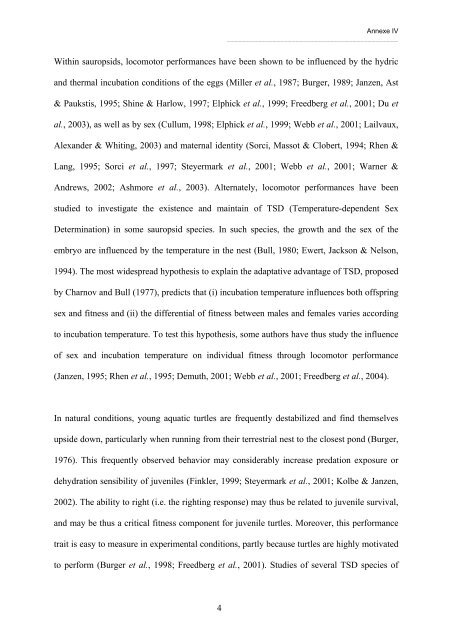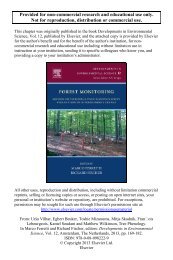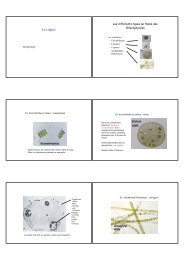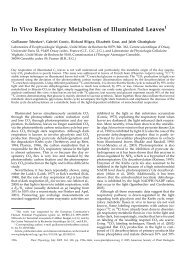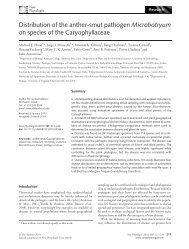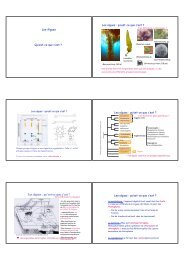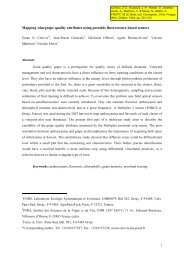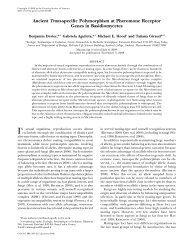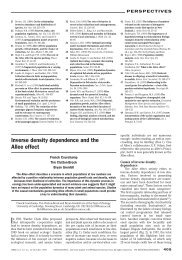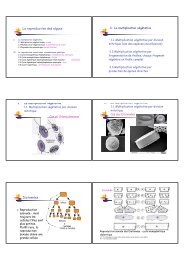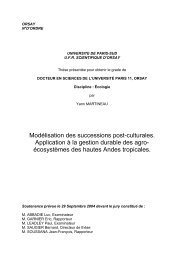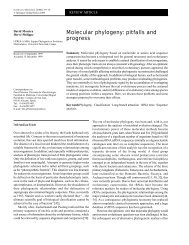Premiers - Outil de Suivi des Contrats
Premiers - Outil de Suivi des Contrats
Premiers - Outil de Suivi des Contrats
Create successful ePaper yourself
Turn your PDF publications into a flip-book with our unique Google optimized e-Paper software.
Annexe IV<br />
_____________________________________________<br />
Within sauropsids, locomotor performances have been shown to be influenced by the hydric<br />
and thermal incubation conditions of the eggs (Miller et al., 1987; Burger, 1989; Janzen, Ast<br />
& Paukstis, 1995; Shine & Harlow, 1997; Elphick et al., 1999; Freedberg et al., 2001; Du et<br />
al., 2003), as well as by sex (Cullum, 1998; Elphick et al., 1999; Webb et al., 2001; Lailvaux,<br />
Alexan<strong>de</strong>r & Whiting, 2003) and maternal i<strong>de</strong>ntity (Sorci, Massot & Clobert, 1994; Rhen &<br />
Lang, 1995; Sorci et al., 1997; Steyermark et al., 2001; Webb et al., 2001; Warner &<br />
Andrews, 2002; Ashmore et al., 2003). Alternately, locomotor performances have been<br />
studied to investigate the existence and maintain of TSD (Temperature-<strong>de</strong>pen<strong>de</strong>nt Sex<br />
Determination) in some sauropsid species. In such species, the growth and the sex of the<br />
embryo are influenced by the temperature in the nest (Bull, 1980; Ewert, Jackson & Nelson,<br />
1994). The most wi<strong>de</strong>spread hypothesis to explain the adaptative advantage of TSD, proposed<br />
by Charnov and Bull (1977), predicts that (i) incubation temperature influences both offspring<br />
sex and fitness and (ii) the differential of fitness between males and females varies according<br />
to incubation temperature. To test this hypothesis, some authors have thus study the influence<br />
of sex and incubation temperature on individual fitness through locomotor performance<br />
(Janzen, 1995; Rhen et al., 1995; Demuth, 2001; Webb et al., 2001; Freedberg et al., 2004).<br />
In natural conditions, young aquatic turtles are frequently <strong>de</strong>stabilized and find themselves<br />
upsi<strong>de</strong> down, particularly when running from their terrestrial nest to the closest pond (Burger,<br />
1976). This frequently observed behavior may consi<strong>de</strong>rably increase predation exposure or<br />
<strong>de</strong>hydration sensibility of juveniles (Finkler, 1999; Steyermark et al., 2001; Kolbe & Janzen,<br />
2002). The ability to right (i.e. the righting response) may thus be related to juvenile survival,<br />
and may be thus a critical fitness component for juvenile turtles. Moreover, this performance<br />
trait is easy to measure in experimental conditions, partly because turtles are highly motivated<br />
to perform (Burger et al., 1998; Freedberg et al., 2001). Studies of several TSD species of<br />
4


